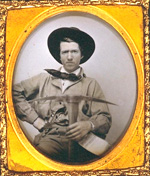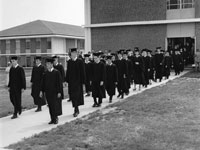The Wren Building
Louise Kale, director of the Historic Campus, outlines the history and restoration of the College of William and Mary's Wren Building, completed in 1700.
Louise Kale, director of the Historic Campus, outlines the history and restoration of the College of William and Mary's Wren Building, completed in 1700.

This archive provides more than 81,000 images and 1,000 texts on the history and culture of California. Images may be searched by keyword or browsed according to six categories: history, nature, people, places, society, and technology. Topics include exploration, Native Americans, gold rushes, and California events.
Three collections of texts are also available. Japanese American Relocation Digital Archive furnishes 309 documents and 67 oral histories. Free Speech Movement: Student Protest, U.C. Berkeley, 19641965 provides 541 documents, including books, letters, press releases, oral histories, photographs, and trial transcripts.
UC Berkeley Regional Oral History Office offers full-text transcripts of 139 interviews organized into 14 topics including agriculture, arts, California government, society and family life, wine industry, disability rights, Earl Warren, Jewish community leaders, medicine (including AIDS), suffragists, and UC Black alumni.

Charts the institutional history of George Mason University from its beginnings in 194950 as an adult education extension of the University of Virginia located in northern Virginia, through its formal separation from UVA in 1960, to its present-day existence as a multi-campus university.
Offers more than 30 documents and nearly 50 photographs related to the history, a 400-word biography of George Mason, an annotated chronology, and a current 108-page fact book. Of interest to those studying the history of education and Virginia history.

This collection of more than 100 primary texts, essays, biographical sketches, obituaries, book reviews, and partially annotated links explores the cultural, intellectual, and political trends of the 1950s. Organized alphabetically and according to lesson plans, this eclectic collection of readings is structured around a few landmark texts and topics, including McCarthyism and anticommunism, Daniel Bell's The End of Ideology (1960), William H. Whyte's The Organization Man (1956), feminism, Philip Rieff's The Triumph of the Therapeutic (1966), and conformity in universities.
Materials include substantial excerpts from Vance Packard's The Status Seekers (1959) and the Encyclopedia of the American Left, in addition to retrospective analyses of the postwar period.
Historian Carroll Gibbs looks at the relationship of Georgetown University to the Georgetown African-American community, from the school's 1789 founding to the present day. He focuses particularly on the arrival of Patrick Healy, the first head of a U.S. university to be acknowledged as of African descent, in 1873.
To view this video, select "Scholars," followed by "Carroll Gibbs." Choose one of the Windows Media options.
Professor Lucas E. Morel discusses the history of affirmative action in the U.S., looking at how it has changed from the early 1960s to the present day. He examines particularly the 2003 U.S. Supreme Court cases Grutter v. Bollinger and Gratz v. Bollinger, both on affirmative action.
To listen to this lecture, scroll to session thirteen, and select either the RealAudio link or image in the gray bar to the left of the main body of text.
This lecture follows the history of the Bancroft Library, the leading research library for California and Western American history. It details Hubert Howe Bancroft's collection of historical materials, starting in 1859; continues with Bancroft's sale of the collection to the University of California in 1905; and then follows the library's development and leadership to 2005.
To listen to this lecture, scroll down to "A Library for California," and select "Listen to Broadcast."
The Comstock House Historic Site preserves the 1882 home of Solomon Comstock—founder of both the First National Bank and Moorhead State University and an early stakeholder in the creation of a Red River Valley railroad. The interior contains the original Queen Anne Eastlake furnishings.
The site offers period rooms and guided tours.
The Hall displayas photos of each of the hall inductees and the National Championship Trophies for University of Miami Football and Baseball, along with the Heisman Trophies of Vinnie Testaverde and Gino Torretta. A basketball and memorabilia from the Rick Barry years are on display, along with memorabilia from all sports. Also on display is the Seminole War Canoe which was for many years the prize for the winner of the University of Miami vs. Florida Football games. The Trophies for all of the University's Bowl Appearances are on display from the Palm Bowl (the first and original Orange Bowl) to this year's Rose Bowl. The unusual is also on display, including a picture of the University's first collegiate national championship team, the 1931 National Collegiate Polo Championship Team.
The hall offers exhibits.
This NBC documentary charts the lengthy struggle for school desegregation in America, from the Brown v. Board of Education decision in 1954 to the battle to integrate the University of Alabama in 1963.
This feature is no longer available.